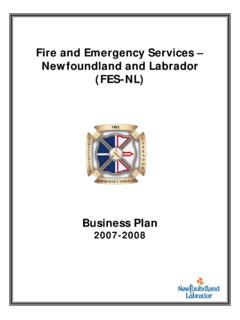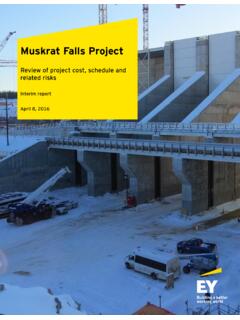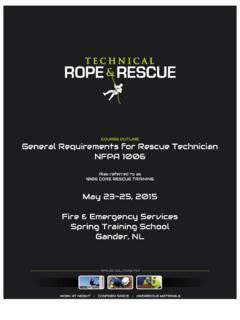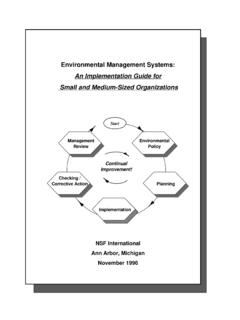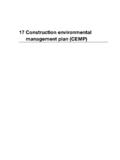Transcription of Guide to Domestic Woodcutting - Government of …
1 Valuable wood Responsible wood use is about obtaining the best value from any tree cut. Forest stands with sawlogs should not be cut for firewood. Leaving low stumps and small tree tops mean less wood wasted. Stumps should be no higher than 15 centimetres (six inches), and tops should be no larger than eight centimetres (three inches) in handling To avoid spills and leaks, proper fuel and oil handling techniques are important. Even a small spill or leak can have damaging effects on water, fish and wildlife. Fuel must be stored in CSA approved containers and refuelingshould not take place within 30 metres of any water body. Theuse of waste oil as chain lubricant is prohibited and all oil should be brought out of the woods and disposed of properly. If a fuel spill or leak does occur, it should be contained and cleaned up immediately. If you are handling large quantities of fuel and oil, spill kits are useful and highly recommended.
2 If the volume of a spill is more than 70 litres, it must be immediately reported to the Canadian Coast Guard Spill Report Line at (709) 772-2083 or preventionGenerally, the forest fire season in Newfoundland and Labrador runs from April to October. During forest fire season, Domestic woodcutters are required to have an Operating Permit, in addition to their Cutting Permits. These permits may be obtained at any Forestry Office. During fire season, Domestic woodcutters must also adhere to the following requirements: Chainsaws and all-terrain vehicles (ATV)must be equipped with appropriate mufflersand spark arrestors to prevent flammabledebris from escaping. When using a chainsaw or riding an ATV onforested land, residents are required to havea fire extinguisher that contains a minimumof 225 grams of ABC class dry can I cut firewood? Domestic Woodcutting is only permitted in designated areas on Crown land.
3 Every Domestic cutting permit contains a map with specific information Domestic cutters should know. Cutting within approved boundaries ensures wood is cut in a sustainable and environmentally friendly manner. If you are unsure of your area, check with your local Forestry Office before you cut. 123456789101112131415160 TOP DIAMETERSTUMP HEIGHTcmGuide toDomestic WoodcuttingSnag and wildlife trees Wildlife will often depend on trees to survive. In particular, birds use dead trees to nest and feed on insects. When cutting wood, it is advisable to leave several trees in an area for wildlife to use. When selecting trees to leave consider: forest animals tend toprefer trees with poor form and variouslevels of decay; the most valuable wildlife trees are greaterthan 50 centimetres (20 inches) in diameter; birch, white spruce, and dead treeswithout branches are the most resistanttrees to wind; trees can include dead (snags), live standing,and clumps of trees that have littlecommercial value; individual trees are good, but clumps canalso remain; large living trees with existing cavities,wounds where rot can occur, broken tops,and dead branches are good candidates.
4 And where possible leave both hardwood andsoftwood trees of different sizes in clumpsProtecting regenerationWhen cutting wood, ensure small trees and seedlings are protected so they may grow into our future firewood and zonesWater is a valuable resource which must be protected from pollution, soil erosion and changes in temperature. During cutting operations, environmental guidelines require a strip of trees to be left around all bodies of water such as streams, brooks, rivers, ponds and lakes. These trees act as buffers and provide habitat and travel corridors for wildlife. Buffer zones help regulate water temperatures and prevent sediment from ending up in water bodies. In Domestic Woodcutting operations, these buffers may vary in width from 30 metres to more than 500 metres depending on the resource being protected. Domestic woodcutters are reminded to review their cutting permit conditions, to determine the specific buffer zone widths for their area of our forests The Government of Newfoundland and Labrador is committed to responsible stewardship of the province s forests, sustainability of the resource, and ensuring forest related activities on Crown land are conducted under approved environmental procedures.
5 Forest operations managed by the province are monitored through an environmental management system , which is currently certified to the ISO 14001 :2015 standard. This leaflet has been developed to provide Domestic woodcutters with an overview of their responsibilities under the system . Stay compliant. Review your cutting permit conditions and more information on our environmental management system , please contact your local district office, or visit: , Forestry and Box 2006 Corner Brook, NL A2H 6J8

